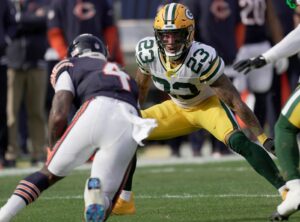Progressing to the the AFC South in our newest installment of “The Breakdown”, we take a look at what the Jacksonville Jaguars do on both sides of the ball.
The Breakdown: A Look at the Jacksonville Jaguars Schematic Philosophy
Vertical Stretches
After a week eight loss to the Titans, Nathaniel Hackett was promoted to offensive coordinator and now looks to promote his Air Coryell system full-time.
A staple of such a system is the vertical stretches that coincide with the horizontal ones, truly emphasizing the stress the system looks to put on the defense. The vertical aspect of the passing game was the catalyst for the acquisition of former tight end Julius Thomas who they hoped to flex and shuffle around the formation. But it never materialized and limited the system’s optimal amount of effectiveness. Jacksonville’s longer-developing routes were a clear mesh with quarterback Blake Bortles‘ lengthy wind-up and their downfield designs off of play-action.
The Air Coryell is built on multiple three-man route combinations that Hackett prefers to run out of bunch sets from a reduced to split to 1) mask his receivers struggles to shake press by providing clean releases and 2) provide ample amount of space for these combos to stretch defenses on both planes. By sending three receivers on such vertical planes, the offense forces the defense to play leverage-sound football by defending both the width and depth of the field, while the vertical portions of the stem provide a mirage-like effect in multiple routes. Their ability to hide the route’s break points-and ultimately their intentions-forces the defenses to play reactive, catch-up football rather than anticipatory football. It further becomes difficult for the defense to play match coverage and disguise their own intentions.
Adding running back Leonard Fournette is a new and potentially-vital aspect to their offense, but it still remains to be seen what type of success Jacksonville can manufacture in the run game this season. The offensive line as a unit were marginal athletes and equal movers in space and along the perimeter, struggling mightily to win on the likes of sweeps, tosses and outside zone. Granted, that’s an alarming amount of red in which can also be attributed to the Jags’ lack of talent at running back. But the line’s underwhelming level of athleticism carried over to runs such as counter and power where they are tasked with pulling and blocking a “gap.”
This ultimately birthed a reliance on runs like Iso and inside zone, runs between the tackles that Fournette is simultaneously best suited for. Expect Jacksonville to create with their play-action looks to offset their struggles in the run game and rely on such play-action on a number of first downs.
More than a Zone
Former Seattle Seahawks defensive coordinator Gus Bradley is no longer the head man in Jacksonville, but current defensive coordinator Todd Wash enters his second season with the Jags and looks to continue to run his zone-based scheme.
Wash and Bradley’s time in Seattle means this zone scheme is eerily similar to what Seattle does with it’s hybrid man looks along the perimeter. Aside from these mixed looks, they operate with a 4-3 scheme that features a bevy of stunts and twists along the line over heavy use of blitzes, a punishing tactic when you have the athleticism the Jaguars have up front. Their LEO and OTTO positions play an integral role in their system. The former, manned by Telvin Smith, works from a looser alignment with primary duties in space while the latter, featuring Paul Posluszny, helps set and control the edge against the run with a blend of pass rush and coverage responsibilities on passing downs.
With the addition of corner back A.J. Bouye and continued growth of stud Jalen Ramsey, the Jaguars have two long, aggressive corners that fit their single-high scheme like a glove. What’s more, defensive end Yannick Ngakoue is a budding star along a defensive line that must find a way to get home on these stunts or twists, or Wash will need to dial up pressure via blitzes. It’s your basic zone that is predicated on forcing turnovers. That’s something the Jaguars found themselves noticeably underwhelming at doing with a mere total of seven last year. And so it remains to be seen just how long they will rely on their four-man rush.
Perhaps the most important aspect of this unit is the blend of youth and talent that (should) factor in to a big season. Just like any other scheme, having the talent athleticism Jacksonville has spells potential to play loose, assignment-based football.






